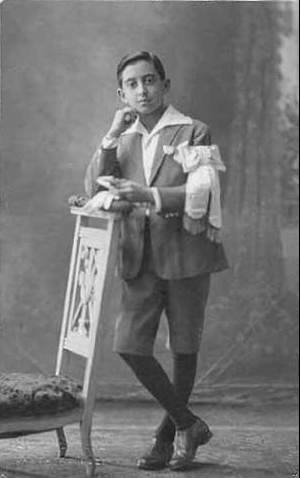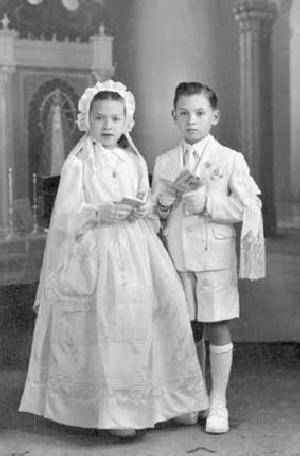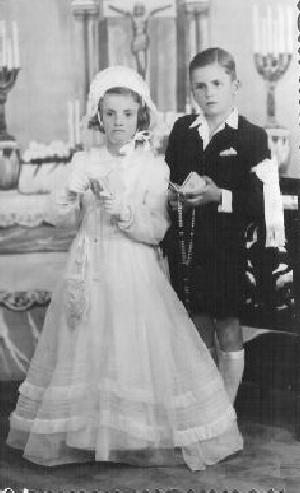
Argentine First Communion Suits: Chronology--20th Century
We know much more about the 20th century First Communions in Argentina . We still see dark suits in the early-20th century. We see some sailor suits. Other boys wear formal Eton collars. The suits were often knee pants worn with long stockings. After World War I we begin to see somw white suits, including white sailor suits. Sailor suits do not seem as common in Argentina as they were in Europe. We see boys wearing both long pnts and short pants suits. Short pants suits were often worn with knee socks. First Communions were often organized a school. Here the class would dress alike for the occasion. White suits seem to have been very popular in the 1950s and 60s. By the late 60s we begin to see less formality. Some boys did not wear suits, but rather hite shirts and dress pants. By the 1980s, fancy suits had become increasingly less common for the boys. Girls continued to wear the junior wedding dresses. One boy at a Catholic school reports wearing the school uniform with a blue blazer or suit coat instead of the smock and a big white flower attached on our left arm. I wore a white short sleeve shirt, blue tie, grey short pants, blue knee socks, black high-fronted shoes and a blue blazer. Another reader reports that when he took his first holy communion, he ws already in secondary school so he wore long pants. Styles changed significantly by the 1980s. Eton suits were gone and white suits no longer common. Boys that could afford to dress up for the occasion mostly wore dark subdued colored suits, grey, dark grey, brown, dark brown. Some boys wore their school uniforms. Wew also see boys with just shirts and ties and not suits.
The 1900s
We know much more about the 20th century First Communions in Argentina . We still see dark suits in the early-20th century. We see some sailor suits. Other boys wear formal Eton collars. The suits were often knee pants. Boy also wore long pants, but knee pants seem more common. The knee pants suots were worn with long stockings. Knee socks do not seem to have been worn at te tome. We do see boys wearing three-quarter socks. Long stockings were preferred by some mothers as more suitable for such a formal occassions. Formal outfits were quite common. Many children had white gloves.

Figure 2.--This boy wears a knee pants suit with dark long stockings. He has an open-collar sports collar. This looks to be a suit worn for First Communion and not a special suit for the occassion. We would guess the portait was taken in the 1910s, but the early 20s is possible.
|
|
The 1910s
We see a greater degree of informality. World war I and gthe prosperity it brought may have been a factor. We note boys wearing both knee pants and long pants suits for First Communion. Knickers see less common. This probably reflects the Italian influence. Many boys received special suits for the occassion. These were usuall dark suits. Some boys wore their regular suits. Unlike the United States we do not see boys wearing knicker suits much in Argentina. Unlike Europe, knee pants in America suddenly went out of style at the end of the 1900s and replaced by knickers in the 1910s. This is one of several indicators suggesting that it was European styles that were prevalent in Argentina. This seems likeky because of the lrge numbers of Itklaisn immigrants. Many boys had elaborate sleeve ribbons. Formal touches like white gloves were still quite common.
After World War I we continue to see boys doing First Communion with open sports or Schiller collars. This was a popular style in the 1910s and 20s. While we have a fairly extensive Argentine archive, most of the portraits are undated. Thisd makes it difficult to establish a precise chronology. While the open collars were common, the rest of th outfits continue to be formal. We also see the fancy sleeve ribbons. Only the boys wore these. We also continue to see boys doing First Communion in knee pants or long short pants suits. We see knee pants both with and without the three decorative buttons ans knee pants made the transition to short pants. We rarely see knicker suits. We begin to see some sailor suits, but not very many. Sailor suits do not seem as common in Argentina as they were in Europe. We see boys wearing both long pants and knee/short pants suits. Short pants were still quite long in the 1920s. We see some done with the ornamental buttons at the knee hem and some without. Short pants grew in popularity during the 1920s, but we still see some knee pants even in the late 1920s. Short pants suits were worn with three-quarter socks and with knee socks. We see three-quarter socks earlier, but not knee socks they seem a new style sen for the first time during the decade. Long stockings were declining in popularity, but were still worn although this gradually became less common as the decade progressed.
Short pants suits were very common for Fitst Communion suits in the 1930s. We see mostly dark suits in the 30s, but we also begin to see some white suits. First Communion photographs become invewasingly available in the 30s. First Communions were often organized at privte Catholic schools, mny of which had uniforms. The class would dress alike for the occasion. We notice quite a few of these school events in the 1930s. Short pants and knee socks seem to have become standard in the 1930s. We see some boys wearing formal Eton suits. The formal Eron suits in additon to the Eton collat had a small black jacket and long trousers, often striped trousers. Other boys might wear Eton collars with regular suits, but this was becoming less common. By the end of the decade we no longer see knee pants. We note fewer boys wearing long stockings and more boys wearing knee socks. Most argentines lived in the north which had a warmer climate than northern Europe. Long stockings were worn more for formilty than warmth. We begin to see more boys wearing white knee socks with their First Communion outfits, with both dark and white suits. We do not see boys wearing white long stockings, but they were worn by girls.

Figure 5--These children we think in the 1940s are both dressed in white. Girls always wore white, boys more commonly wore black, but white was becoming more common. The children in the double portraits are probably siblings. .
|
|
We see both single and double-breasted jackets in the 1940s. We still see most boys wearing dark suits for First Comminion in the 1940s. We also continue to see the white suits that appeared in the 1930s in the 40s and by the end of the decade they seem quite popular. Some of the white suits seem to be off white colors rather than bright white, although this is a little difficult to tell with black and white photographs. We believe that white suits were to a degree a sign of affluence. The thing about white suits is that they were purchased primarily for First Communion. The dark suits might be worn for many other occassions, but the white suits were not as flexible. They were not suitable for most occasions. Thus the white suits were basically a purchase just for First Communion, no problem for affluent prents, but a but of a streach for less well-to-do families. Often families were willing to splurge on their daughters, but less willing to do so for their sons. The white suits were usually short pants suits worn with white knee socks. The dark suits were commonly done in both short and long pants. Short pants suits were very common, but both short and long pants suits were worn. The shorts in the 1940s were similar to the ins orn in the 1930s, rather long cut at knee length. We note both white and dark knee socks, but the white knee socks seem very common. White suits were almost alwaus worn with whit knee socks, but we see both white and dark knee socks with darks suits.

Figure 6.--Here we see a boy and girl during the 1950s dressed up in their First Communion outfit. They were probably sisters. He wears a dark short pants suit with white knee soks. She wears a junior bridal dress..
|
|
The 1950s
Formal wear for First Communion continued to be very common in Argentina during the 1950s. Boys wore mostly sandard sack suits in the 1950s. These wee suit jackets with lapels. Quite a few boys wore suits without ties. This may have been a European style which developed during World War II. Most boys wore ties for a more formal look. We see both dark and white suits in the 1950s. White suits seem to have been very popular. We see boys wearing both dark and white knee socks. White knee socks might be worn with thedark suits, but drl knee suits were mot worn with the white knee socks. Spme bots wore long pants suits, but short pants suits seem nore common. Girls continued to wear formal junior wedding dresses.
The 1960s
We seemore white suits in the 1960s. By the late 60s we begin to see some boys dressing less fornally. One boy at a Catholic school reports wearing "the school uniform with a blue blazer or suit coat instead of the smock and a big white flower attached on our left arm. I wore a white short sleeve shirt, blue tie, grey short pants, blue knee socks, black high-fronted shoes and a blue blazer." Another reader reports that when he took his first holy communion, he ws already in secondary school so he wore long pants.
First Communions were not as common as they were earlier, but most children still did them. And many of them wore formal outfits. This was especially the case for the girls. Quite a number of boys also wore First Communion suits. We note both white and dark suits. There were both short and long pants suits. The stylish cut of short pants became shorter in the 1970s and we see some boys with short-cut short pants suits. This was a popular style in Europe. The length of the shorts was alo affected to a degree by the age of the boy. The length of the shorts, however varied a good deal. White kneesocls were very common, even with dark suits. Some boys wore white shoes with white suits. Black shoes were more common. We evcen see white shoes with dark suits, but this was less common. Some boys did not wear suits, but rather white shirts and dress pants. By the 1980s, fancy suits had become increasingly less common for the boys. Girls continued to wear the junior wedding dresses. And unlike the boys' shorts, the dresses were always long lengths.
The 1980s
Styles changed significantly by the 1980s. Eton suits were gone and white suits no longer common. Boys that could afford to dress up for the occasion mostly wore dark subdued colored suits, grey, dark grey, brown, dark brown. Some boys wore their school uniforms. Wew also see boys with just shirts and ties and not suits.
The 1990s
HBC

Navigate the Historic Boys' First Communion pages:
[Return to the Main Argentine First Communion chronology page]
[Return to the Main Argentine First Communion page]
[Return to the Main Argentine school uniform page]
[Renewals]
[America]
[France]
[Spain]
[Switzerland]
Navigate the Historic Boys' Clothing Web Site:
[Introduction]
[Activities]
[Biographies]
[Chronology]
[Clothing styles]
[Countries]
[Bibliographies]
[Contributions]
[FAQs]
[Glossaries]
[Images]
[Links]
[Registration]
[Tools]
[Boys' Clothing Home]
Navigate the Historic Boys' Clothing Web chronological pages:
[The 1900s]
[The 1910s]
[The 1920s]
[The 1930s]
[The 1940s]
[The 1950s]
[The 1960s]
[The 1970s]
Navigate the Historic Boys' Clothing Web style pages:
[Short pants suits]
[Blazers]
[Jackets]
[Kilts]
[Sailor suits]
[Sailor hats]
[Ring bearer/page costumes]
[Shortalls]
Created: 12:26 AM 4/30/2008
Last edited: 11:38 PM 8/27/2016





